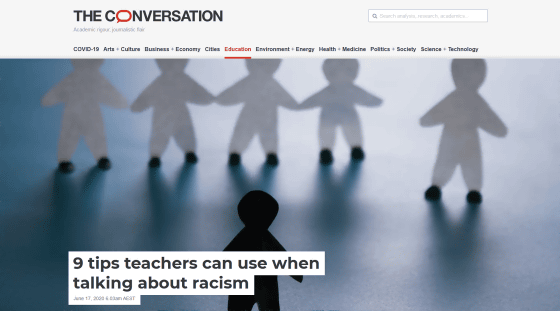What are the nine important points to keep in mind when teaching children about 'racism'?

The
9 tips teachers can use when talking about racism
https://theconversation.com/9-tips-teachers-can-use-when-talking-about-racism-140837

◆1: Communicate accurate and historical background
In providing anti-racism education, it is essential to teach about past racist practices. Australian Prime Minister Scott Morrison falsely stated in a radio interview that 'there was no slavery in Australia,' but denied the historical facts that were in fact, and not to mention, ' It is a hindrance to understanding that racism is affecting modern people.”
Researchers point out that teachers need to be taken to memorials and museums and asked to find nearby places to tell their students about their racist past. It seems that there are many cases of racism in the place name, for example, the place name 'Boundary Road' that is occasionally seen in Australia is called 'Boundary Road' by Australian indigenous people 'Do not go beyond here. It may be derived from the border line that was decided.
◆2: Explain that racism is not only done by 'bad people'
Racism is a system of racial hierarchy that is maintained consciously or unconsciously based on the idea that one group of people is superior to another. Based on conscious and unconscious superiority, the culture, assertion, and expertise of a particular group are considered 'standards', while others are considered inferior.
It seems that in recent years the form of racism has become more unconscious, and if you think that 'racism is something that 'bad people' do,' 'good people' will become their daily lives. He said he would not have the opportunity to overlook the hidden unconscious discrimination and review the racist structure of society. Therefore, teachers need to teach that 'racism is done unconsciously even by good people'.

◆ 3: Teach about the effects of unintended racism
People often fall into the idea that 'your will is more important than the consequences.' However, even if the behavior of a person who does not intend to racist acts, the consequences of racist behavior will not reduce the impact on the victim. ..
If you inadvertently give someone hot coffee, it's more appropriate to apologize 'I'm sorry' than to argue, 'Why are you angry when you didn't mean that?' Even in racial discrimination, it is important to acknowledge your mistakes and apologize, and be more cautious in your future actions.
◆ 4: Encourage courage to speak out for racist behavior
There is the belief that continuing silence while seeing racist behavior is responsible for maintaining the structure of racism as a result. As a result, teachers teach students how to give constructive feedback when they see racism, while at the same time giving them the “flexibility” to accept their claims if someone says they are racist. It is necessary to give support.

◆5: Explain that there are various levels in racial discrimination
Racism is not simply divided into “discriminating side” and “discriminating side”, but the forms of discrimination are intricately mixed according to various characteristics of individuals. As a result, the content of discrimination experienced by 'black men' and 'black women' may differ greatly, and 'while being suppressed in one respect but in a privileged hierarchy in another' I have to teach the students that there are cases where they are 'existing'.
◆ 6: Consider the racial trauma of students
When educating about racism, there is a risk that teachers will not consider racism as a 'progressive student problem', but just as an educational topic. Teachers think that 'students may also have racist trauma,' and not only need to teach how to resist those who incite racism, but also need to help trauma sufferers. That.
Teachers can warn students and prepare them in advance when talking about delicate topics about racism in the classroom. You should also check what racial background students are in your class and consider avoiding potentially traumatic examples, images or movies.

◆7: Model comprehensive behavior
Teachers need to model their behavior in the classroom and prevent racist behavior. Students should not say anything inappropriate about the culture or racial background of other children, or the idea that a particular culture is better than another is not good. It is also the role of the teacher to teach.
◆8: Ensuring curriculum diversity
As a result of the colonial policy, education centered on the knowledge and experience of white people is being conducted in Australia and the United States, but it is also important to educate from a different perspective when changing awareness of racism. .. Therefore, it is necessary to ensure the diversity of the curriculum by incorporating materials such as knowledge, reading materials, and images of another culture into the curriculum.
◆9: Focus on change, not blame someone or shame yourself
Anti-racism education should never blame anyone or humiliate oneself, but must overcome the discomfort that creates change. Teachers need to teach students the right history, but at the same time, focus on the inaccurate history that has unknowingly taken root and stereotypes for other races, question their own thoughts, and encourage change. There is.

Related Posts:
in Note, Posted by log1h_ik







